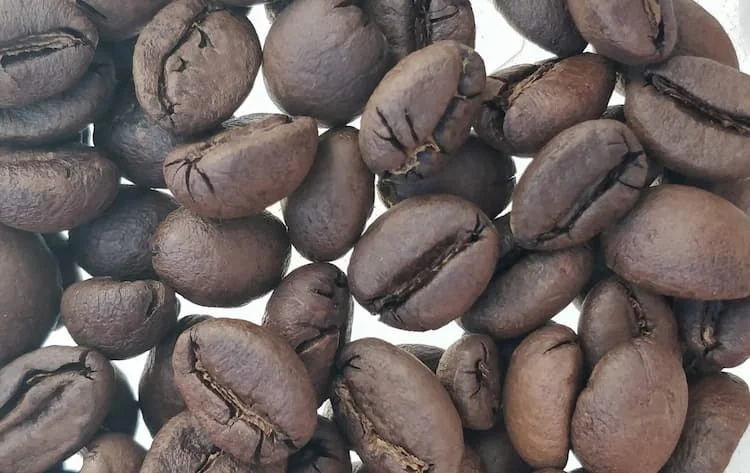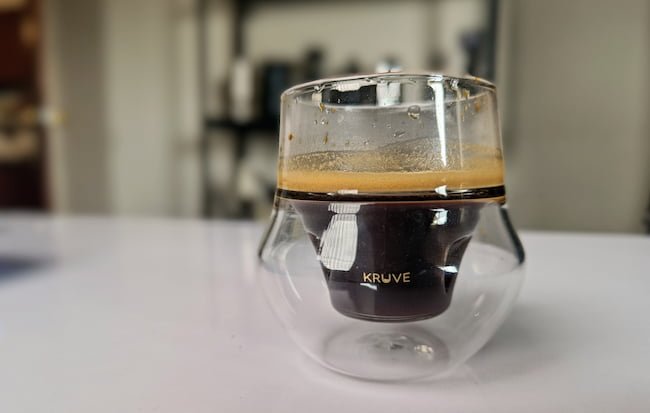Have you ever pondered the enigma that is the caffeine content in espresso?
It’s a topic that’s more complex than most folks realize, and it’s saturated with myths and misunderstandings.
In this article, we’ll dive into the nitty-gritty of caffeine in espresso and offer some tips for those worried about their caffeine intake… as well as those looking to maximize it ☠️
Caffeine Content in an Espresso Shot
Among caffeinated beverages, espresso is commonly regarded as the uncontested heavyweight champion, packing a potent punch of 125 milligrams of caffeine in a double shot on average.
Generally, 400 mg is viewed as the daily upper threshold for caffeine consumption.
It would indeed be intriguing if we had a daily recommended intake for espresso, but in the absence of such guidance, an informed estimation might suggest that two double espressos could suffice to rouse most individuals and sustain them through a typical workday.
However, delve a little deeper and you’ll find the subject of caffeine in espresso to be far more intricate than it initially appears.
Factors influencing caffeine
Various factors can impact the amount of caffeine present in a shot of espresso, such as:
- Coffee Bean Type: There are two primary coffee bean species – Arabica and Robusta. Robusta beans contain almost twice as much caffeine as Arabica. f you ever try a 100% Robusta shot, you’ll know what we’re talking about. It can be pretty wild stuff.
- Brewing Method: Different brewing techniques can impact caffeine extraction. For example, using more water in an espresso (turning it into a lungo, effectively) may increase caffeine content compared to a ristretto.
- Contact Time: Longer brewing times with more water can result in more caffeine being extracted.
- Roast Degree: Darker roasts don’t necessarily contain more caffeine, but since they are less dense, using more beans per cup (if dosing by weight) can increase the total level of caffeine.
- Dose: Well, this one is a bit obvious, but it’s worth repeating. Many places use 18-20 grams for a double shot of espresso, but there are also more traditional places where only 14 grams are used. Of course, this difference in dose will impact overall caffeine content.
The bottom line: Espresso is not just espresso. If you want the most potent, hard-hitting shot of all time, go for a dark roast 100% Robusta coffee.
Instead of making a typical espresso shot, you should pull a lungo to extract as much caffeine as possible.
Caffeine Content by Espresso Shot Size
The number of shots in your espresso can significantly impact the caffeine content. Keep in mind that many specialty coffee shops use double shots as standard
- Single espresso shot (1 ounce): Contains approximately 63 milligrams of caffeine
- Double espresso shot (2 ounces): Contains approximately 125 milligrams of caffeine
- Triple espresso shot (3 ounces): Contains approximately 188 milligrams of caffeine

Filter coffee is more caffeinated than espresso
Even though espresso, on the surface, seems like the most potent type of coffee, filter coffee might be a more efficient way to extract caffeine.
James Hoffmann, a renowned figure in the specialty coffee world, recently analyzed caffeine content in coffee using a Lighttells CA-700 caffeine analyzer.
The study focused on the influence of brewing methods on caffeine content and found remarkable results.
In one comparison, brewing 18 grams of coffee as an espresso yielded 110 mg of caffeine, while using the same amount in a filter coffee resulted in 170 mg of caffeine.
This surprising finding revealed that filter coffee contains almost 50% more caffeine than espresso when you compare brewing efficiency.
Caffeine content in coffee shops and chains
In a different experiment, Hoffmann looked at espresso shots from a wide range of coffee shops; both specialty and commercial.
- The caffeine content ranged from 85 mg – 175 mg across the commercial chains
- The specialty coffee shops were more consistent in their extractions, producing shots between 110-135 mg
- Starbucks had the weakest espresso shot of all, with only 85 mg per double shot
- McDonald’s double shot was 107 mg per double shot
Source: YouTube
Hoffmann also did another experiment to understand the difference between filter and espresso extraction.
Both types of coffee showed quick extraction of solubles and caffeine initially, but espresso’s caffeine extraction lagged behind its total extraction. This suggested a possible connection between caffeine extraction and contact time, where a 2-minute brew is ideal.
However, there is a caveat to all these experiments: Even though an espresso shot is less efficient, it’s still much more concentrated than filter coffee. Remember that specialty coffee shops often serve double-shot espressos as the standard nowadays.
Espresso vs. Other Coffee Types
As Hoffmann’s experiment shows above, espresso does not have more caffeine than other coffee types by serving. The caffeine content in espresso is higher per ounce, but a standard serving size of espresso (1 ounce) is much smaller than other coffee beverages (6-8 ounces).
Let’s compare the caffeine content of espresso with other brewing methods:
- Drip coffee (8 ounces): Contains approximately 95 milligrams of caffeine
- French press (8 ounces): Contains approximately 80 milligrams of caffeine
- Turkish coffee (2 ounces): Contains approximately 50 milligrams of caffeine

Espresso-Based Drinks and Caffeine Content
The caffeine concentration in espresso-based drinks varies due to the additional ingredients that are added. However, the total caffeine content is the same Here’s how these ingredients can affect the overall caffeine content:
- Milk: Adding milk to espresso (as in a cappuccino or latte) dilutes the caffeine content, resulting in a lower caffeine concentration compared to a straight shot of espresso. But the total amount is still the same.
- Cream or fat: Adding cream or fat to coffee can affect the absorption of caffeine in the body. Fats can slow digestion, causing caffeine to be absorbed gradually, which may result in a smoother caffeine high. This is what proponents of butter/bulletproof coffee often claim.
Ideal Caffeine Intake and Safety
The FDA recommends a daily caffeine intake of up to 400 mg for healthy adults. Overall, it looks like there’s a correlation between caffeine intake and health (source).
Depending on cup size, this is roughly comparable to four 8-ounce cups of brewed coffee or six single espresso shots.
This is in line with neuroscientist Dr. Andrew Huberman, who recommends that the beneficial dosage of caffeine depends on an individual’s tolerance and adaptation to caffeine, which can vary substantially based on food consumption. For optimal focus, Huberman recommends ingesting 100 to 200 milligrams of caffeine before concentrated work.
Misconceptions Around Caffeine Intake
- Everyone can safely consume the same amount of caffeine: This is false, as genetics, weight, and lifestyle factors can influence individual tolerance.
- More caffeine equals better focus and alertness: Overconsumption can lead to jitters, anxiety, and sleep disruptions.
Understanding Consumption Habits for a Better Espresso Experience
To make the most of your espresso experience without the unwanted side effects, consider the following tips:
- Sip slowly: Enjoy your espresso at a leisurely pace to give your body time to metabolize the caffeine.
- Time it right: Consume caffeinated beverages earlier in the day to avoid disrupting your sleep cycle.
Personally, I have a pretty strict rule to stop coffee drinking around 4 PM every day. Everyone’s different, so you might have to call it earlier or later. While some people may consume caffeine late in the day and still fall asleep, research suggests that late caffeine intake can disrupt sleep architecture, leading to poorer quality sleep. - Combine with green tea: The compound L-Theanine in green tea can take the edge off anxiousness and make the caffeine ride smoother and more enjoyable.
Further Reading: The “Dead Espresso Shot: Facts and Fiction
A single shot of espresso (approximately 1 ounce) typically contains around 63 milligrams of caffeine. However, this amount can vary depending on factors like the type of coffee bean and the brewing method.
Yes, the type of coffee bean significantly affects the caffeine content. There are two primary coffee bean species – Arabica and Robusta. Robusta beans contain almost twice as much caffeine as Arabica.
The size of an espresso shot significantly impacts its caffeine content. For instance, a single espresso shot contains around 63 milligrams of caffeine, a double shot contains approximately 125 milligrams, and a triple shot contains around 188 milligrams.
Per serving, filter coffee often contains more caffeine than espresso. This is because the brewing process for filter coffee typically involves more extended contact time with the coffee grounds, allowing more caffeine to be extracted. However, it’s worth noting that espresso is more concentrated, so it has a higher caffeine content per ounce.
